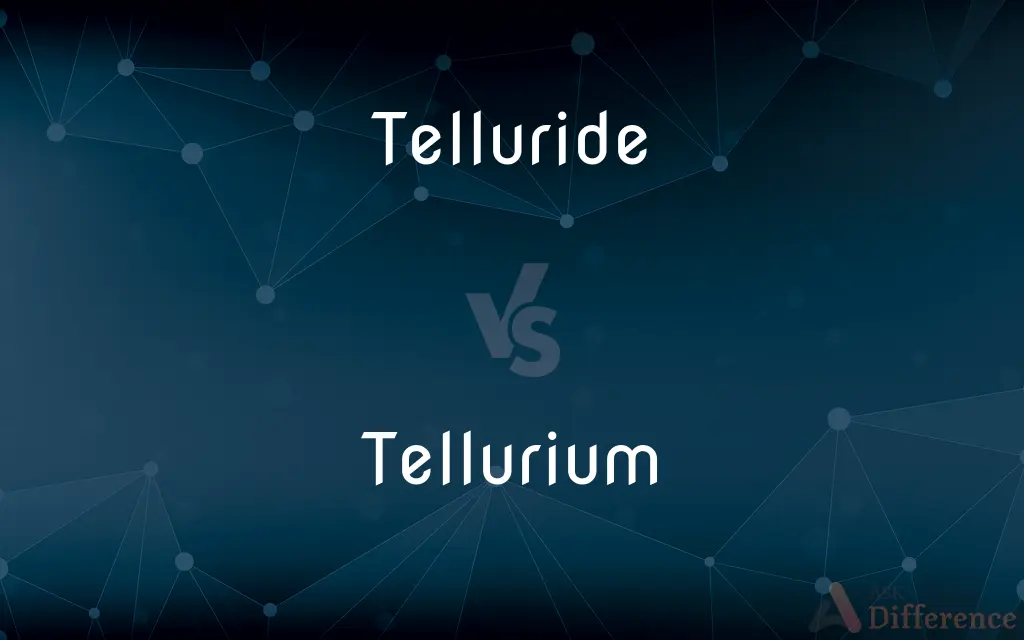Telluride vs. Tellurium — What's the Difference?
Edited by Tayyaba Rehman — By Maham Liaqat — Updated on April 30, 2024
Telluride refers to a chemical compound containing the element tellurium and another element, usually a metal; tellurium is a chemical element itself, symbolized as Te and atomic number 52.

Difference Between Telluride and Tellurium
Table of Contents
ADVERTISEMENT
Key Differences
Telluride compounds are chemical combinations where tellurium acts as a non-metal component bonded with metals. On the other hand, tellurium is a pure element found in the periodic table under the chalcogen group.
In the context of chemistry, tellurides are used to denote specific types of salts or binary compounds, such as cadmium telluride, a material significant in semiconductor technology. Whereas, tellurium itself is a rare, silvery-white metalloid essential in various industrial applications including metallurgy and electronics.
The properties of tellurides vary significantly depending on the metal they are combined with, impacting their electrical conductivity and other physical characteristics. In contrast, tellurium has distinct properties, such as high conductivity in certain forms and a melting point of 449.5°C.
From an economic perspective, tellurides are important in the extraction and processing of certain precious metals like gold and silver, where tellurium is often a byproduct. Meanwhile, tellurium's uses extend beyond this, including its role in creating phase change memory materials.
Environmental and health considerations also differentiate them; tellurides, depending on the metal involved, can have various toxicities and environmental impacts. On the other hand, tellurium exposure is primarily a concern in industrial settings due to its potential toxicity when inhaled or ingested.
ADVERTISEMENT
Comparison Chart
Definition
A compound of tellurium with a more electropositive element.
A chemical element with atomic number 52.
Type
Chemical compound
Chemical element
Key Uses
Important in semiconductor technology and metal recovery.
Used in metallurgy, electronics, and as an alloying component.
Properties
Properties vary based on the metal combined with tellurium.
Silvery-white, brittle metalloid with high electrical conductivity in certain forms.
Environmental Impact
Varies depending on the metal and usage.
Mainly concerns in industrial settings due to potential toxicity.
Compare with Definitions
Telluride
Essential in electronics manufacturing.
Telluride compounds are in some semiconductors.
Tellurium
Exhibits semiconductor properties.
Tellurium's conductivity increases with light exposure.
Telluride
Varies in composition and properties.
Each metal telluride has unique characteristics.
Tellurium
A metalloid in the periodic table.
Tellurium is found between selenium and polonium.
Telluride
A binary compound containing tellurium.
Cadmium telluride is used in solar panels.
Tellurium
Utilized in various industrial applications.
Tellurium is added to improve the machinability of copper.
Telluride
Can be toxic, requiring careful handling.
Workers handle telluride compounds with caution due to toxicity risks.
Tellurium
Found in specific minerals and ores.
Tellurium is often a byproduct of copper refining.
Telluride
A substance used in metal recovery.
Gold telluride ores are processed for gold extraction.
Tellurium
Requires safe handling due to its toxicity.
Industrial precautions are necessary when working with tellurium.
Telluride
Divalent tellurium, or a compound of tellurium, especially a binary compound of tellurium with a more electropositive element.
Tellurium
Tellurium is a chemical element with the symbol Te and atomic number 52. It is a brittle, mildly toxic, rare, silver-white metalloid.
Telluride
A binary compound of a metal with tellurium; metal salts of tellurane
Tellurium
A brittle, silvery-white, rare metallic element usually found in combination with gold and other metals, produced commercially as a byproduct of the electrolytic refining of copper and used in compact discs, semiconductors, ceramics, and blasting caps and (in the form of bismuth telluride) in thermoelectric devices. In alloys it improves the machinability of stainless steel or copper, and increases the durability and hardness of lead. Atomic number 52; atomic weight 127.60; melting point 449.5°C; boiling point 988°C; specific gravity 6.23 (20°C); valence 2, 4, 6. See Periodic Table.
Telluride
Any organic compound of general formula R2Te (R not = H), the tellurium analogues of ethers
Tellurium
(uncountable) The chemical element with atomic number 52. Symbol: Te. A rare, brittle, mildly toxic, silver-white metalloid.
Telluride
Sylvanite
Tellurium
(countable) A single atom of this element.
Telluride
A compound of tellurium with a more positive element or radical; - formerly called telluret.
Tellurium
A variant spelling of tellurion.
Telluride
Any binary compound of tellurium with other more electropositive elements
Tellurium
A rare nonmetallic element, analogous to sulphur and selenium, occasionally found native as a substance of a silver-white metallic luster, but usually combined with metals, as with gold and silver in the mineral sylvanite, with mercury in Coloradoite, etc. Symbol Te. Atomic weight 125.2.
Tellurium
A brittle silver-white metalloid element that is related to selenium and sulfur; it is used in alloys and as a semiconductor; occurs mainly as tellurides in ores of copper and nickel and silver and gold
Common Curiosities
What are the key uses of tellurides in industry?
They are crucial in semiconductors and metal recovery processes.
Can tellurium be found in nature?
Yes, it's typically found as a byproduct in the refining of copper and other metals.
Is tellurium a metal?
Tellurium is a metalloid, meaning it has properties of both metals and non-metals.
What is tellurium used for?
It's used in metallurgy, electronics, and as an alloying component.
Are tellurides toxic?
Toxicity can vary widely, largely dependent on the other element in the compound.
How do the properties of tellurides vary?
Their properties change depending on the metal they're combined with.
How does tellurium affect the environment?
It mainly poses risks in industrial settings due to its potential toxicity.
What are tellurides?
Tellurides are compounds composed of tellurium and a more electropositive element.
What makes tellurium unique among elements?
Its properties as a metalloid and its semiconductor behavior under light.
Why is tellurium considered rare?
It's scarce in the Earth's crust and primarily obtained as a byproduct of refining other metals.
Share Your Discovery

Previous Comparison
Petrol vs. Water
Next Comparison
Newspaper vs. JournalAuthor Spotlight
Written by
Maham LiaqatEdited by
Tayyaba RehmanTayyaba Rehman is a distinguished writer, currently serving as a primary contributor to askdifference.com. As a researcher in semantics and etymology, Tayyaba's passion for the complexity of languages and their distinctions has found a perfect home on the platform. Tayyaba delves into the intricacies of language, distinguishing between commonly confused words and phrases, thereby providing clarity for readers worldwide.
















































